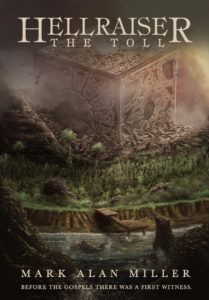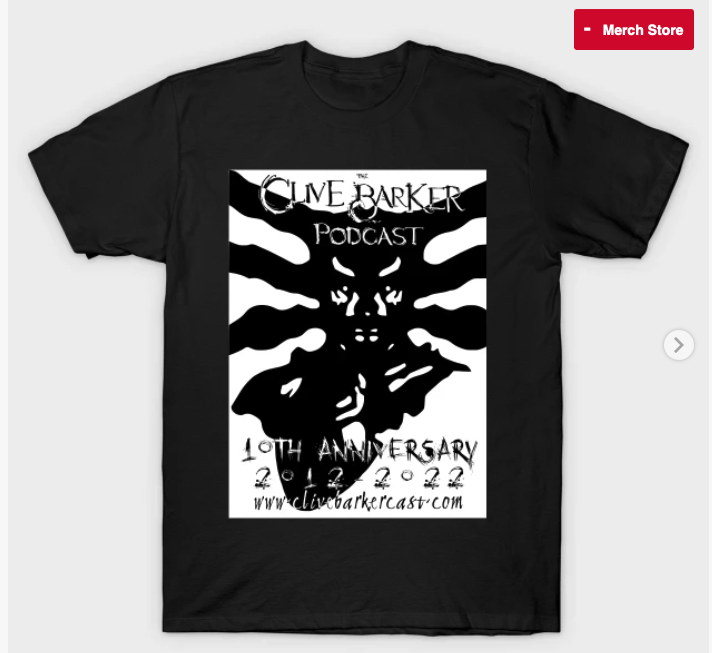“Hellraiser: The Toll” by Mark Miller [Review]
Disclaimer: I tried my best to limit the plot elements to what’s mentioned in the Subterranean Press’ synopsis, but there may be minor spoilers during this advance review.
Mark Miller brings us a new Hellraiser novella, based on a short story Clive Barker had partially written that kept bouncing around the office since at least 2010 called “Heaven’s Reply“. If you’ve been paying attention, you may have heard us talk about this story, and how it was used to make a Hellraiser Reboot script a couple of years ago involving Lemarchand and the French Guiana’s Devil’s Island prison. That movie never happened. In Ryan‘s spoiler-free review for The Toll, he added this quote from Mark Miller:
“It evolved from Heaven’s Reply. That’s how it began, as the short Story Heaven’s Reply. Clive didn’t know where to take it, and [we] had the idea that it could tie into The Scarlet Gospels. So I thought about how to do it, and then sort of backwards engineered it from there and made it my own.” – Mark Miller, via e-mail, 09.26.2017
So, rather than let this story die a dusty death inside a drawer, they went to work, and The Toll is the result.
We are treated to the return of a familiar character, but there are a few things to remember first. This is the Hellraiser literary universe, not the movie universe. This Kirsty is not Kirsty Cotton, and she’s not Larry Cotton’s daughter – she’s Rory’s friend from The Hellbound Heart (HBH). The rest of her story is the same in broad strokes— what she went through with Frank and the Cenobites. She isn’t very detailed in this novel as a character, and I think this is deliberate, because let’s face it: people reading this will be bringing the image of Ashley Laurence and Doug Bradley‘s characters into it. That’s their unavoidable baggage as Hellraiser fans that will shape these characters in particular. The “Hellpriest” of The Scarlet Gospels (SG) was already a slightly different character than HBH’s lead cenobite, transplanted from the movie series with his non-jeweled pins, for the purposes of being given a “good death” in a kind of catharsis in response to the franchise’s sequels like Hellraiser: Revelations, about which Clive once said:
I have NOTHING to do with the fuckin’ thing. If they claim its from the mind of Clive Barker,it’s a lie. It’s not even from my butt-hole.
— Clive Barker (@RealCliveBarker) August 21, 2011
Apart from the different Kirsty and Rory, every other element referenced in this story that deals with the events of Lodovico Street are taken from the Hellraiser film, not HBH. In this story, Julia killed those men with a hammer instead of a knife, Kirsty summoned Pinhead in the hospital room after opening Lemarchand’s musical box, instead of the cenobite with “bells hanging from the flesh of his neck“, and she remembers holding a box with golden decorated panels when she did it, instead of the “six black lacquered faces” in HBH. I always told myself Carston Goode in SG could have had a different box in his house as a trap for D’Amour, other than the one in the familiar tragedy of HBH (I subscribe to the idea that several of Lemarchand boxes exist), but now Kirsty remembers the movie version of the box. I’m sure few people will notice this, however for some of you expecting the literary universe to be coherent between all three books, this may shake you out of the page at times and make you question whether the Mandela Effect is a real thing.
We were told writing this review that Clive approved these changes to the story of #55, Lodovico Street’s events to fit his own re-imagining for the original Hellraiser script (Clive will sign the $250 lettered edition of The Toll along with Mark Miller). Where that leaves HBH, it’s hard to say and I have a hard time discarding that version. I think The Hellbound Heart is a magnificent little novella, complex and innovative in its depiction of the archetypal Faustian tale. There’s a great elegance to it. If everything else is to be snapped to the film version wouldn’t it be easier to just make this Kirsty Cotton? Changing that character in this novella would be as easy as just changing the surname “Singer” to “Cotton”, as it would not affect the character in any meaningful way.
From Subterranean Press‘ order page for Hellraiser: the Toll, (which is still currently misspelling it ‘Hellrasier’ after almost 3 weeks) we can read: “With equal parts economy and eloquence, author Mark Alan Miller brings to life the beginning of the end as The Toll expands the Hellraiser universe, and shows that before Harry D’Amour’s adventures in The Scarlet Gospels, there was a first witness to Pinhead’s infernal plan.“
This novella is about 80 pages long out of the 96 that comprise the book, and is interspersed with several of Clive Barker’s sketches and little hand-drawn typographical elements here and there, especially at the beginning of chapters. I read this story through in 3 hours, that’s how long it took me, your experience may be different. The length of book chapters comes in some measure from the times when novels or stories were serialized in parts that would come out with every issue of a magazine or newspaper, and in modern books I think they still survive out of tradition and it is sometimes useful to structure story transitions, like the passing of time, changing the action from one character plotline to another, etc. For this story, which is very fast paced, it’s still divided in Prologue, Parts 1 and 2, several Chapters for each part and an Epilogue for 80 pages of storytelling. I didn’t notice any major breaks in the flow, but some parts did feel like they didn’t need a chapter break.
Going back to Subterranean’s blurb, The Toll “tells the story of what happened between Clive Barker’s iconic works The Hellbound Heart and its follow up, The Scarlet Gospels.” To me, it seemed to start at the beginning of the events of The Scarlet Gospels (SG), and end after them. So it’s more of a parallel companion story. Kirsty Singer is never really described physically or otherwise in The Toll, but if we are to compare her to the Kirsty of the HBH, then she originally was depicted as apologetic-sounding, perpetually defeated and dreamy, who can’t even brew a cup of coffee “without minor traumas“, but my brain kept bringing up Ashley Laurence and filling her spot in this story to fight the lack of information about her. However as you’ll find out, this Kirsty Singer does not act like that anymore. Three decades after her traumatic meeting with the forces of Hell, she’s unrecognizable from the HBH Kirsty. The synopsis continues: “Thirty years after Kirsty Singer escaped from the clutches of the Hell Priest, Pinhead, and lived to fight another day, her life has never been the same. Every few years she fashions a new name, a new identity, and a new home for herself; She is a woman who is running from her past at all costs, which is why it comes as such a surprise when she receives a mysterious letter in the mail, addressed to the woman she’s been running from over half her life.”
I was a bit taken aback with the complexity of her “secret agent” life, with safe houses around the world including Paris, passports under different names, etc. when we’re never given any insight on how she got to this point or what she’s been doing during those last 30 years to support this lifestyle, apart from being told she turned her escape from Hell into a full-time job. HBH’s Kirsty is 26 years old during the events at Lodovico Street, so this Kirsty should be a 56 year old woman in The Toll, and the story should reflect that.
“Answering the letter’s query, she begins a descent down a rabbit hole to the ultimate confrontation. Her actions stir something unnamable in the ether, and throw her into a game where nothing—not even what she sees in front of her very eyes—can be trusted.” This mysterious man Kirsty never meets affects her more than you’d imagine. She ends up throwing caution to the wind and decides to visit a certain house in London, a few chapters I felt were some of the best of the story; Kirsty comes to the realization that the world is full of illusions put in place by powers much greater than us, powers that change the world as they see fit without anyone realizing, when all people do is just look around without seeing. Kirsty sees it, and the illusion cracks. It takes her a week to decide to contact the author of that letter, and after a very brief phone conversation, within 40 hours she leaves London to reach Devil’s Island in the French Guiana, knowing full well that at the end of that trip “The Cold Man” will be waiting.
This isn’t the real Devil’s Island, however. Instead of a cruise ship destination for curious tourists, it’s described as a fantastic decaying empty place, complete with access by row boat. The story moves quickly from this point on, splattered here and there with violence and blood —then the jungle engulfs the rest of the story. The Penal Colony, ruined and covered in vines, inhabited by empty cells, holds a dark doorway in its deepest heart, and Kirsty finds that place and The Cold Man, as she meets him at the crossroads “between the real and the realer still” to quote HBH.
The tagline in the cover of this book reads: “Before the Gospels there was a first witness.” So you have an idea of Pinhead’s intentions for this Kirsty. Does it ever happen? I’m not entirely sure. To quote the God Entity in Futurama, “When you do things right, people won’t be sure you’ve done anything at all.” The final act wraps up in the last 10 pages, with plenty of references to the Scarlet Gospels and echoes of Pinhead and Hell’s final fate reaching Kirsty by third-party here and there, but it’s all offered as a quick narration in a few sentences. Does finding out about an event from third-party sources make you a witness to it? Personally, I remained unsure about what was Pinhead’s plan for Kirsty and where she’s left after the events of this story. There’s another layer revealed about Pinhead’s strategy that could get activated in the future, but after the cataclysmic events of The Scarlet Gospels, I don’t see where this can progress towards or exactly why this is revealed, unless Mark Miller plans to release more episodic Hellraiser novellas. If you’ve read The Scarlet Gospels, you know that the powers of Good and Evil have abandoned their fight.
Clive Barker wrote The Scarlet Gospels so he could ultimately dispatch Pinhead, as he’d grown weary of the character and increasingly bad movie sequels. He wanted to get rid of him on his own terms and send him off like a Viking funeral, in flaming glory. The Scarlet Gospels were marketed as “The last Pinhead story” in the promotional materials, and it may yet be – if you see this as a companion of sorts to the Gospels, an extra. Who knows what the future holds?

Pros:
- You can imagine this is the movie Kirsty and enjoy the brief but intense meeting between her and the “Hellpriest”.
- Interesting setting at Devil’s Island, brilliant location vignette at Lodovico Street.
- Brief references to key characters from the Hellraiser mythology.
- It’s always great to see the Lead Cenobite re-appear.
- Great looking cover by Brandon Mahlberg.
Cons:
- Short, “slice of life” story that reads very fast.
- Long setup and quick wrap-up in the last 10 pages that feels like it could be the beginning of something longer and more satisfying.
- Unclear motivations behind some characters.
- Brings back threads from The Scarlet Gospels story without offering much closure.
- I really expected the cover to depict something relevant about the story, but it’s just an interesting illustration.
- Does a soft retcon of The Hellbound Heart novella that hit me as jarring, regardless of Clive’s approval.
Hellraiser: The Toll is up for pre-order from Subterranean Press, and it will be released in January 2018, in two different editions:
- Limited: 724 numbered cloth bound copies signed by Mark Alan Miller at $40.00
- Lettered: 26 signed leatherbound copies, housed in a custom traycase, signed by Clive Barker and Mark Alan Miller at $250.00



























